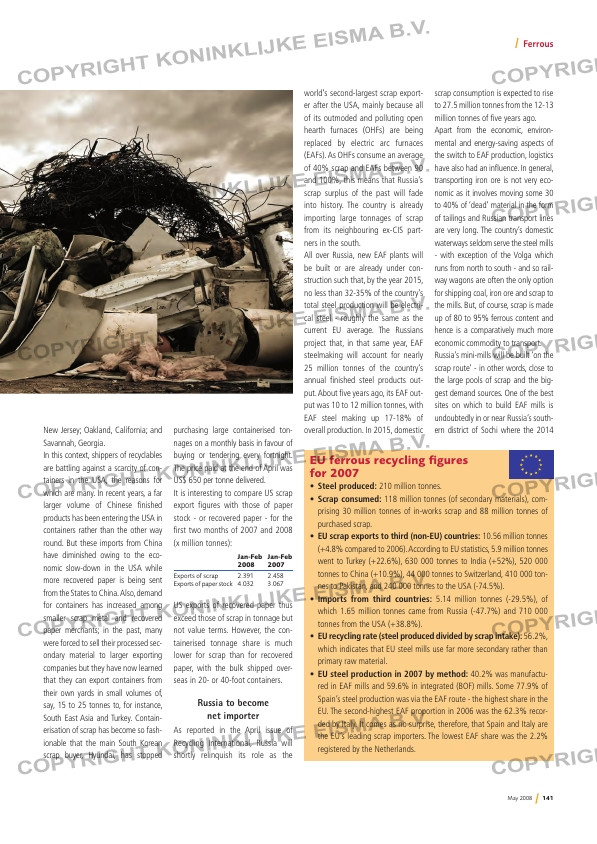Page 141 from: May 2008

May 2008 141
New Jersey; Oakland, California; and
Savannah, Georgia.
In this context, shippers of recyclables
are battling against a scarcity of con-
tainers in the USA, the reasons for
which are many. In recent years, a far
larger volume of Chinese finished
products has been entering the USA in
containers rather than the other way
round. But these imports from China
have diminished owing to the eco-
nomic slow-down in the USA while
more recovered paper is being sent
from the States to China. Also, demand
for containers has increased among
smaller scrap metal and recovered
paper merchants; in the past, many
were forced to sell their processed sec-
ondary material to larger exporting
companies but they have now learned
that they can export containers from
their own yards in small volumes of,
say, 15 to 25 tonnes to, for instance,
South East Asia and Turkey. Contain-
erisation of scrap has become so fash-
ionable that the main South Korean
scrap buyer, Hyundai, has stopped
purchasing large containerised ton-
nages on a monthly basis in favour of
buying or tendering every fortnight.
The price paid at the end of April was
US$ 650 per tonne delivered.
It is interesting to compare US scrap
export figures with those of paper
stock – or recovered paper – for the
first two months of 2007 and 2008
(x million tonnes):
Jan-Feb Jan-Feb
2008 2007
Exports of scrap 2.391 2.458
Exports of paper stock 4.032 3.067
US exports of recovered paper thus
exceed those of scrap in tonnage but
not value terms. However, the con-
tainerised tonnage share is much
lower for scrap than for recovered
paper, with the bulk shipped over-
seas in 20- or 40-foot containers.
Russia to become
net importer
As reported in the April issue of
Recycling International, Russia will
shortly relinquish its role as the
world’s second-largest scrap export-
er after the USA, mainly because all
of its outmoded and polluting open
hearth furnaces (OHFs) are being
replaced by electric arc furnaces
(EAFs). As OHFs consume an average
of 40% scrap and EAFs between 90
and 100%, this means that Russia’s
scrap surplus of the past will fade
into history. The country is already
importing large tonnages of scrap
from its neighbouring ex-CIS part-
ners in the south.
All over Russia, new EAF plants will
be built or are already under con-
struction such that, by the year 2015,
no less than 32-35% of the country’s
total steel production will be electri-
cal steel – roughly the same as the
current EU average. The Russians
project that, in that same year, EAF
steelmaking will account for nearly
25 million tonnes of the country’s
annual finished steel products out-
put. About five years ago, its EAF out-
put was 10 to 12 million tonnes, with
EAF steel making up 17-18% of
overall production. In 2015, domestic
scrap consumption is expected to rise
to 27.5 million tonnes from the 12-13
million tonnes of five years ago.
Apart from the economic, environ-
mental and energy-saving aspects of
the switch to EAF production, logistics
have also had an influence. In general,
transporting iron ore is not very eco-
nomic as it involves moving some 30
to 40% of ‘dead’ material in the form
of tailings and Russian transport lines
are very long. The country’s domestic
waterways seldom serve the steel mills
– with exception of the Volga which
runs from north to south – and so rail-
way wagons are often the only option
for shipping coal, iron ore and scrap to
the mills. But, of course, scrap is made
up of 80 to 95% ferrous content and
hence is a comparatively much more
economic commodity to transport.
Russia’s mini-mills will be built ‘on the
scrap route’ – in other words, close to
the large pools of scrap and the big-
gest demand sources. One of the best
sites on which to build EAF mills is
undoubtedly in or near Russia’s south-
ern district of Sochi where the 2014
Ferrous
EU ferrous recycling figures
for 2007
• Steel produced: 210 million tonnes.
• Scrap consumed: 118 million tonnes (of secondary materials), com-
prising 30 million tonnes of in-works scrap and 88 million tonnes of
purchased scrap.
• EU scrap exports to third (non-EU) countries: 10.56 million tonnes
(+4.8% compared to 2006). According to EU statistics, 5.9 million tonnes
went to Turkey (+22.6%), 630 000 tonnes to India (+52%), 520 000
tonnes to China (+10.9%), 44 000 tonnes to Switzerland, 410 000 ton-
nes to Pakistan, and 240 000 tonnes to the USA (-74.5%).
• Imports from third countries: 5.14 million tonnes (-29.5%), of
which 1.65 million tonnes came from Russia (-47.7%) and 710 000
tonnes from the USA (+38.8%).
• EU recycling rate (steel produced divided by scrap intake): 56.2%,
which indicates that EU steel mills use far more secondary rather than
primary raw material.
• EU steel production in 2007 by method: 40.2% was manufactu-
red in EAF mills and 59.6% in integrated (BOF) mills. Some 77.9% of
Spain’s steel production was via the EAF route – the highest share in the
EU. The second-highest EAF proportion in 2006 was the 62.3% recor-
ded by Italy. It comes as no surprise, therefore, that Spain and Italy are
the EU’s leading scrap importers. The lowest EAF share was the 2.2%
registered by the Netherlands.
RI_051_MA_Ferrous.indd 3 14-05-2008 14:02:16



